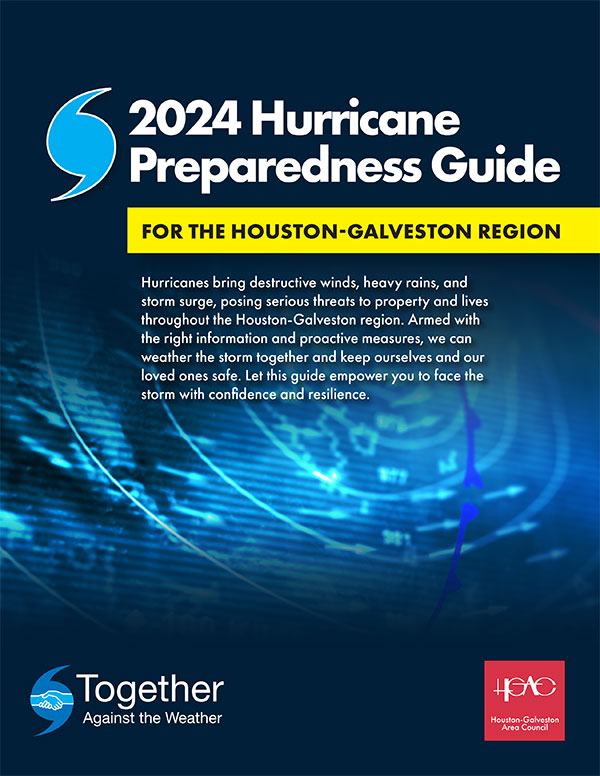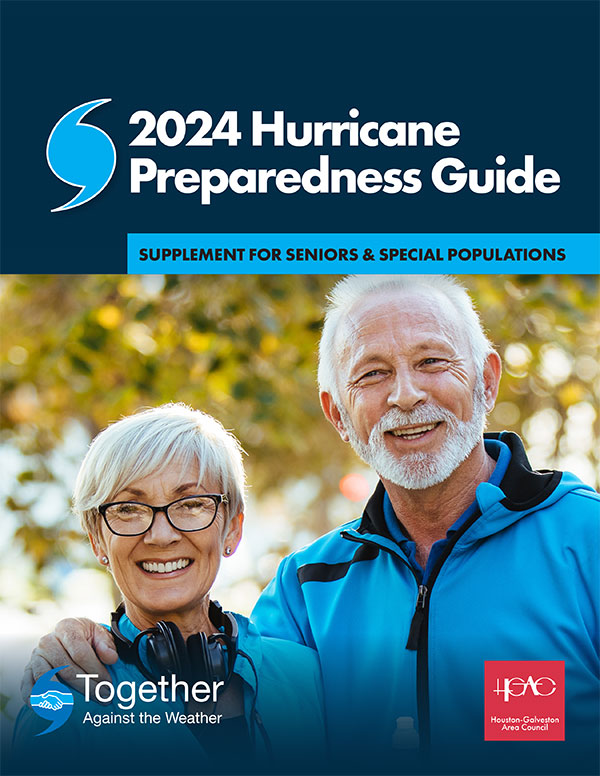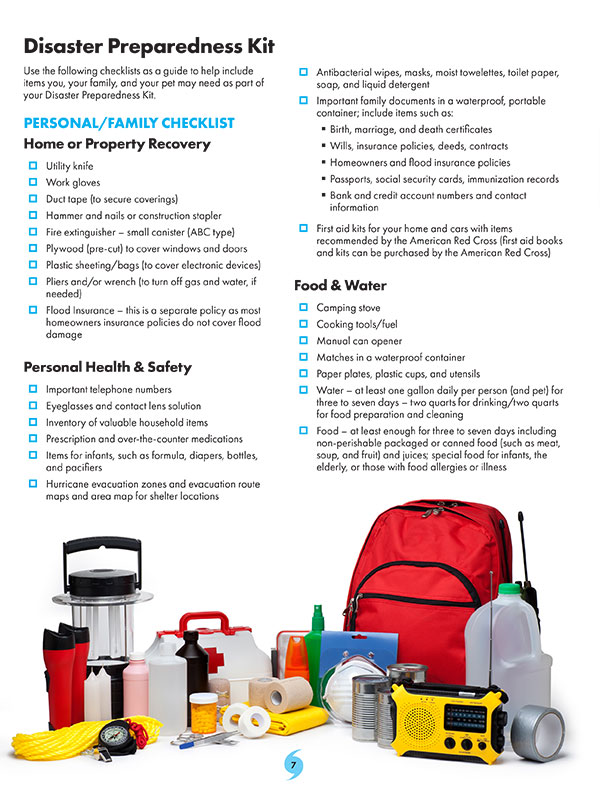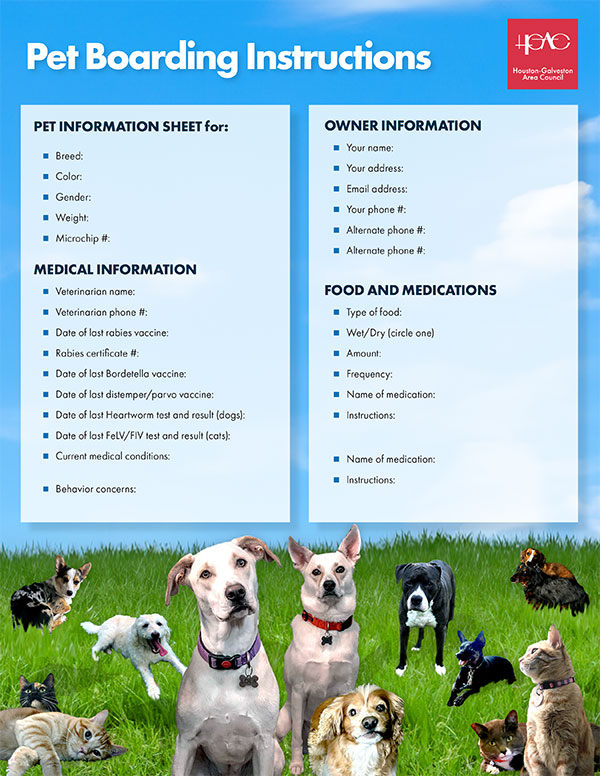On This Page
Before a Storm
Hurricanes and storm surges are major threats to the Houston-Galveston region, and depending on the severity of the storm, it may become necessary to evacuate portions of the area. To prepare for a storm, secure your home, gather essential supplies, create a detailed emergency plan, understand your risk zone, and stay continuously informed through reliable weather updates. Remember these three steps:
Step 1: Have a Plan
Planning is critical to making sure you can evacuate quickly and safely. Your Disaster Preparedness Plan will help guide you and your family’s response and actions during a hurricane, tropical storm, flood, or other natural disaster. The best time to create a plan is before hurricane season when you have time to plan and consider alternatives. If you wait before a hurricane arrives, you will be rushing to prepare your family as well as your home.
Coastal residents should take extra steps to prepare for an evacuation by becoming familiar with their evacuation zone and the evacuation routes in their community.
Build Your Kit

Create an emergency supply kit with essential supplies you will need to take with you when evacuating. If you’re not sure where to start, check out this H-GAC Hurricane Disaster Preparedness Kit, which includes essential items to protect you, your family, and your pets. Shop early and give yourself more time to buy emergency supplies. Have refills for prescriptions and other medical supplies your family uses regularly. If you have pets, we encourage you to utilize our Pet Disaster Checklist, compiled to help you in the event of an evacuation with your pet. Additionally, we have provided Pet Boarding Instructions in case you need to board your pet. It's essential to have these resources ready in case of an evacuation. Visit ready.gov/pets for more information about preparing pets for a natural disaster.
Residents who shelter in place during a hurricane or severe storm should have a well-stocked emergency supply kit. Below are some essential items every kit should include:
- Water (one gallon per person per day for at least three days, for drinking and sanitation)
- Food (at least a three-day supply of non-perishable food)
- Battery-powered or hand crank radio and a NOAA Weather Radio with tone alert
- Flashlight
- First aid kit
- Extra batteries
- Whistle (to signal for help if needed)
- Dust masks (to help filter contaminated air)
- Moist towelettes, garbage bags and plastic ties (for personal sanitation)
- Wrench or pliers (to turn off utilities)
- Manual can opener
- Local maps
- Cell phone with chargers and a backup battery
Visit ready.gov for more information on how to prepare your home and family for a hurricane and other disaster planning tips.
Review Important Documents
There are several essential documents you will want to take with you or safeguard in the event of an evacuation. These documents include your identification, insurance information, and medical information.
Make sure these documents are current and take measures to safeguard them now. Make copies and keep them in a safety deposit box or a secure, password-protected digital space. Visit ready.gov for a full list of critical documents to safeguard to prepare for a natural disaster.
Prepare Your Family

Hurricanes bring destructive winds, heavy rains, and storm surge, posing serious threats to property and lives throughout the Houston-Galveston region. Armed with the right information and proactive measures, we can weather the storm together and keep ourselves and our loved ones safe. Let this guide empower you to face the storm with confidence and resilience.
Residents who live outside the hurricane evacuation zones should be prepared to shelter in during a severe storm. Prepare an emergency supply kit with enough non-perishable food and water for at least three days. If you have pets or large animals in your care, plan to have enough food to last them for several days. Also, plan for relatives with medical or special needs.
Visit TogetherAgainstTheWeather.com for more information on how to prepare seniors and individuals who may be ill or have a disability for hurricane season. For detailed guidance and resources, access the 2024 H-GAC Hurricane Preparedness Guide Supplement for Seniors & Special Populations.
You may need to evacuate quickly during a hurricane. Make sure every member of your household is familiar with your evacuation zone, evacuation routes, and where you will stay. Practice with your family and pets. If you or anyone in your household has a disability, identify if you may need additional help during an evacuation. Residents with special needs can sign up for the State of Texas Emergency Assistance Registry (STEAR). The STEAR program provides local emergency planners and first responders with additional information on the needs in their community. Learn more about STEAR at tdem.texas.gov/stear.
Shelter-in-Place Safety Tips
Pay close attention to the local news for emergency updates and official instructions. Stay inside, away from windows, skylights, and glass doors. Before the storm, turn your refrigerator and freezer to their coldest settings. This will keep food fresh longer if the power goes out. Store water in clean bathtubs, jugs, and bottles.
If the power goes out, unplug all appliances, TVs, stereos, and computers not connected to a surge-protected outlet. Doing this will reduce potential damages from power surges when electricity is restored. Store valuables and personal documents in waterproof containers. Keep flashlights handy.

Step 2: Know Your Zone
When a tropical storm or hurricane threatens the Houston-Galveston region, the National Weather Service will forecast the expected height of storm surge and wave action. This information is used by emergency management officials to order evacuations.
Local emergency officials use a zone system to order evacuations based on the anticipated heights and extent of storm surge to remove residents in danger of being flooded by storm surge.
You should only evacuate if you live in a storm surge evacuation zone or are ordered by elected and emergency officials to evacuate.
2024 Hurricane Evacuation Zone Map
If it becomes necessary to evacuate residents during a hurricane, authorities will issue evacuation orders by zip code zone or “zone.” Coastal residents should become familiar with zone in which they reside.
Knowing your zone will help you better understand when and if you need to evacuate during a hurricane or other serious storm. It will also help you avoid unnecessary evacuation travel, thereby reducing highway congestion, easing overcrowding at local storm shelters, and boosting public safety.
Download a detailed zip code map to find your hurricane evacuation zone and evaluate your evacuation plans.
How to Use Zone and Evacuation Route Maps

It is important to know your evacuation zone and nearby available hurricane evacuation ahead of time so you and your family can evacuate quickly and safely when necessary. Hurricane evacuations are staggered to prevent highway congestion and allow for quicker, safer movement of people. If an evacuation becomes necessary, orders will be issued by emergency management personnel based on zones.
Using the Zone Map

The Houston-Galveston region has four zone areas, classified based on their level of threat from storm surge.
Use the hurricane zone maps to easily find your evacuation zone so that you’ll be ready to move quickly if your zone is announced. If you have other family members who live in a coastal area, become familiar with their evacuation zone as well. You may be able to help them with their evacuation plans.
Zone maps are updated each year before hurricane season.
2024 Evacuation Route Map
Only evacuate when you are instructed to do so by local officials. By waiting until your zone is called to evacuate, you will help reduce congestion and enhance roadway safety for fellow travelers. At the same time, when your zone is called to evacuate, leave immediately. Do not wait until the last minute. When it is time to leave, follow any guidelines and directions given on routes and what to do.
After the storm has passed, pay close attention to emergency officials’ instructions through local news reports and emergency alerts. They will announce when it is safe to return to the area. There may still be hidden hazards that first responders and emergency officials need to clear before residents can safely return to their homes.
For more information on how to plan for a hurricane evacuation and for other disaster preparedness resources, visit ready.gov, the official website of the U.S. Department of Homeland Security and download a detailed evacuation map to help determine the best route for your family's safety.
Using the Evacuation Route Map

Hurricane evacuation routes are specially designated roadways used to supply the safest and most timely evacuation of coastal areas during a hurricane threat.
Once you are familiar with your zone, it is important to know the evacuation routes near you.
Download and save a copy of the evacuation route map so you know how to safely and quickly leave the area. Evacuation route maps are updated each year before hurricane season.
Step 3: Stay Informed
Staying informed during hurricane season is essential for ensuring the safety of your family and property. Regularly monitor local news channels, radio broadcasts, and official weather websites for the latest updates on storm developments. Sign up for emergency alerts and notifications from trusted sources to receive real-time information. Social media platforms can also provide timely updates but verify the credibility of the sources to avoid misinformation. Download the FEMA app and receive real-time alerts from the National Weather Service for up to five locations nationwide. Be aware of the Emergency Alert System and Wireless Emergency Alert, which requires no signup.
To help you stay informed, we have compiled a comprehensive PDF resource list available for download, featuring reliable information sources and essential tips. By staying informed, you can make timely decisions about evacuations, sheltering, and other critical actions to protect yourself and your loved ones during a hurricane.
Other Resources for Hurricane Preparedness
See below for more resources from H-GAC and our community partners on how to prepare for hurricane season in Texas.
Together Against the Weather

H-GAC’s Together Against the Weather website provides information to individuals with special needs and their caregivers. Visit TogetherAgainstTheWeather.com for more information on how to prepare for hurricane season.
FEMA Flood Map – “Know Your Risk”

FEMA's interactive map allows residents to enter an address and see whether a home is in a high-risk flood zone. Become familiar with your risk of floods and flood-related hazards before they occur.
Harris County Interactive Evacuation Map

The Harris County Office of Emergency Management has developed an interactive evacuation map to help residents decide if they live in an evacuation zone. Find out if your residence is in an evacuation zone to help develop your hurricane plan.
Partner Resources

H-GAC works closely with many federal, state, regional, and local agencies to prepare for severe weather events and plan regional evacuation routes. Visit our Preparedness Resources page for more information on how to plan for severe weather and other emergencies from our partners throughout the region.
After a Storm
After a storm, it is essential to prioritize safety and begin the recovery process.
- Assess your property for damage, avoiding any hazards such as downed power lines or floodwaters.
- Follow instructions from local authorities regarding when it is safe to return and any necessary precautions.
- Document any damage for insurance purposes and initiate repairs promptly.
- Staying informed and taking immediate, careful steps will aid in a swift and effective recovery.
Below are some valuable resources to assist you after a storm has passed.
Disaster Debris Cleanup and Management Resources
This resource provides customizable outreach templates and tools for local governments and partners to inform communities before, during, and after debris-generating events. It includes graphics for social media, websites, and flyers; instructional flyers and videos on proper debris sorting and disposal; public information/news release templates; and tips for setting up a call center.
H-GAC Disaster Recovery Resources and Funding
The H-GAC Disaster Recovery Resources and Funding page is designed to provide a comprehensive list of resources tailored to emergency and disaster recoveries.








